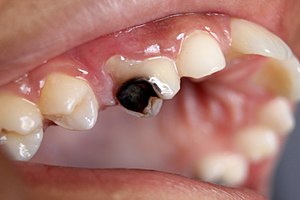WHAT IS TOOTH DECAY?
Tooth decay are also referred to as tooth caries or dental caries or tooth cavities. They are permanently destroyed areas of the tooth that results into tiny holes.
They initially develop as softening of the tooth structures (enamel and dentine). They are caused by bacteria. These bacteria are found on the sticky plaque located on the surfaces of the teeth, so any carbohydrate found in the mouth is broken down by those bacteria into acid.
These acids produced continually will act on our teeth enamel and dentine and weaken it leading to those tiny holes. Tooth decay is among the most common health problems in the world and occurrence is more common in children compared to adult.
Examples of foods causing tooth decays include cake, chocolates, carbonated soft drinks, fruits, breads, breakfast cereals, milk etc. If the teeth aren’t properly cleaned after consumption of the above listed food items, it may result to tooth decay.
WHAT ARE THE SIGNS AND SYMPTOMS OF TOOTH DECAY?
Signs and symptoms of tooth decay varies a lot. It is very possible for tooth decay to be present on a tooth without any symptoms of pain. But as the decay gets larger, the symptoms will manifest. These symptoms include:
- Tooth ache or tooth pain – can be a sharp pain or continuous pain that keeps a person awake with no obvious trigger;
- Tooth sensitivity – complaints of shocking sensation to either sweet, cold or warm water/ drinks and also while eating;
- Grey, brown or black spots appearing on the teeth;
- Bad breath- dental cavity is also accompanied with bad breath;
- Unpleasant taste in the mouth;
- Visible holes or pits on the teeth;
- Pain and discomfort when chewing.
RISK FACTORS
Everyone who has teeth is at a risk of getting cavities or tooth decays. Below are factors that can increase the risk:
- Position of the tooth – most posterior or back teeth are usually affected compared to the front teeth because it is relatively more difficult to clean the back teeth;
- Food likes milk, sweet, mints, ice cream, chocolates that cling to the surfaces of the teeth are more likely to cause tooth decay;
- Bedtime feeding of babies- mothers tend to feed their babies leaving the milk formula, juice or other sugar containing liquids on their teeth for hours as they sleep. This may result in tooth cavity known as baby- bottle dental caries;
- Poor oral hygiene – not brushing properly or not brushing at all;
- Dry mouth – lack of saliva causes tooth-decay because saliva on its own prevents decay by washing away food or plaques that cling to the tooth and also saliva counteracts the acid produced by bacteria. Certain medications can cause dry mouth, we should be watchful of the kind of medications given.
HOW CAN WE PREVENT TOOTH DECAY?
- Brushing your teeth at least twice a day and ideally after every meal using fluoride containing tooth paste. In addition, you can clean in between teeth using dental floss or interdental brushes;
- Use of mouth rinse especially those containing fluoride and antibacterial agent;
- Visit the dentist regularly, twice in a year (every six months);
- Avoid frequent snacking and sipping in between meals or last thing at night because if you snack or drink throughout the day, your teeth will undergo constant attack from the continuous production of acid from the snacks;
- For a person with dry mouth, it advised to chew xylitol-based gum along with prescription fluoride and antibacterial rinse to help reduce tooth decay.
TREATMENT
Treatment of tooth decay depends on the extent of damages on the teeth before the person reports to the dentist
- For early tooth decay, the dentist can start by advising patient on his/her social and diet habits, reducing the amount of sugar in the diet. Secondly, application of fluoride gel or paste to replenish and strengthen the tooth and make the teeth more resistant to decay.
- For a decay that is presenting pain, your dentist may do dental filling with or without a local anesthesia after diagnostic examination.
- For a decay that has spread to the pulp, an advance procedure like root canal treatment may be done. In addition to the root canal treatment, a crown may be placed over the restored tooth
- For a badly damaged and painful tooth decay that cannot be restored, it may need to be removed.
